河海大学土力学总复习review-soil
河海大学高等土力学试卷教学提纲

河海大学高等土力学试卷《2012年河海大学高等土力学》——《土工原理》2012-05-161.土体在沉淀以后,抗剪强度有什么变化趋势?为什么?(8分) p128(p116)答:土体沉淀后,不同的主应力方向下土的抗剪强度不同:竖向抗剪强度高于水平抗剪强度。
这是因为天然的土通常在沉积过程中,长宽比大于1的针、片、棒状颗粒在重力作用下倾向于长边沿水平方向排列而处于稳定的状态,近似于水平层的沉淀,由于长期自重的作用,促成土颗粒排列有一定的方向性,这就形成了土层的各向异性结构,土层的各向异性结构导致土的力学性质上的各向异性。
2.土体中有机质对土体有什么影响?(8分) p4土壤中的有机质存在是土区别于一般固体物质的主要特性之一,有机质是土壤固相物质中最易变化、性质最不稳定的组分。
有机质对土体性质影响的一般规律:随着有机质含量的增加,土的分散性加大,天然含水率增高,干密度减小,胀缩性增加,压缩性增加强度减小,承载力降低,对工程极为不利。
3.十字板剪切实验中,竖向剪切强度与两端水平剪切强度哪个大?为什么?(7分)p102答:(十字板剪切实验是一种利用十字板剪切仪在现场测定土的抗剪强度实验的方法,这种方法适合于现场测定饱和粘性土的原位不排水强度,特别适用于均匀饱和软粘土。
对于粘土中夹带薄层细、粉砂或贝壳,用该方法测得强度偏高。
)现场土常常是各向异性的,对于正常固结土,水平面上的抗剪强度一般小于垂直面上的抗剪强度。
产生各向异性的原因在于:土的成层性和土中的应力状态不同。
4.三轴实验中的破坏规范主应力之差和主应力之比,有什么不同?有什么区别?(7分)p124答:不同的取值规范有时会得到不同的强度参数,一般有最大主应力差规范max 31)(σσ-(当应力应变曲线不出现峰值的时,则取轴向应变15%对应的最大主应力差)和最大有效应力比规范两种。
两种取值规范求得强度参数的差异将取决于实验中孔隙水应力的发展过程,也就取决于实验类型和式样的剪切类型。
期末土力学复习资料
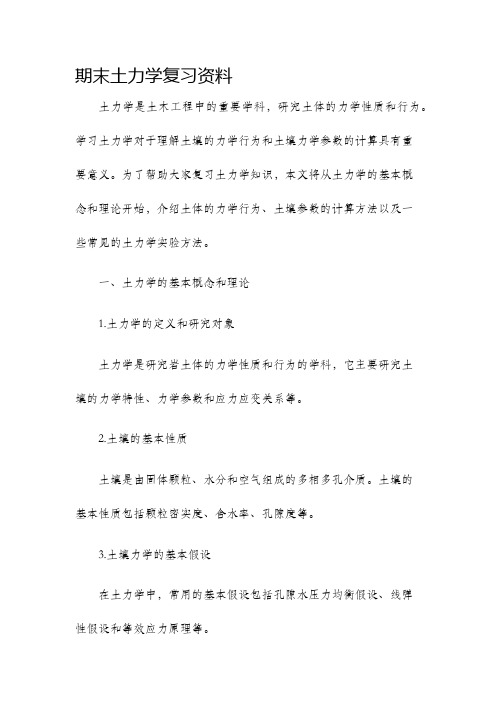
期末土力学复习资料
土力学是土木工程中的重要学科,研究土体的力学性质和行为。
学习土力学对于理解土壤的力学行为和土壤力学参数的计算具有重
要意义。
为了帮助大家复习土力学知识,本文将从土力学的基本概
念和理论开始,介绍土体的力学行为、土壤参数的计算方法以及一
些常见的土力学实验方法。
一、土力学的基本概念和理论
1.土力学的定义和研究对象
土力学是研究岩土体的力学性质和行为的学科,它主要研究土
壤的力学特性、力学参数和应力应变关系等。
2.土壤的基本性质
土壤是由固体颗粒、水分和空气组成的多相多孔介质。
土壤的
基本性质包括颗粒密实度、含水率、孔隙度等。
3.土壤力学的基本假设
在土力学中,常用的基本假设包括孔隙水压力均衡假设、线弹
性假设和等效应力原理等。
二、土体的力学行为
1.土体力学参数
土体力学参数主要包括弹性模量、剪切模量、泊松比、内摩擦角、内聚力等。
这些参数对于描述土体的力学性质和行为至关重要。
2.土壤的压缩性行为
土壤在受到外加压力时会发生压缩行为,这是由于土壤颗粒重
排和水分压缩引起的。
了解土壤的压缩性行为对工程设计和土地利
用具有重要的影响。
3.土体的剪切行为
土体的剪切行为是指土壤在受到剪切应力时的变形和破坏过程。
了解土体的剪切行为对于土方工程的设计和施工至关重要。
三、土壤参数的计算方法
1.黏塑性土壤的力学参数计算。
河海大学复试土力学题04

土力学试卷及答案土木、水利、交通类专业 统考 2004.12一.名词解释(每小题2分,共16分) 1. 塑性指数液限和塑限之差的百分数值(去掉百分号)称为塑性指数,用P I 表示,取整数,即:P L P w w I -=l w —液限,从流动状态转变为可塑状态的界限含水率。
P w —塑限,从可塑状态转变为半固体状态的界限含水率。
2. 临界水力坡降土体抵抗渗透破坏的能力,称为抗渗强度。
通常以濒临渗透破坏时的水力梯度表示,称为临界水力梯度。
3. 不均匀系数不均匀系数的表达式:1060d d C u =式中:60d 和10d 为粒径分布曲线上小于某粒径的土粒含量分别为60%和10%时所对应的粒径。
4. 渗透系数当水力梯度i 等于1时的渗透速度(cm/s 或m/s )。
5. 砂土液化液化被定义为任何物质转化为液体的行为或过程。
对于饱和疏松的粉细砂,当受到突发的动力荷载时,一方面由于动剪应力的作用有使体积缩小的趋势,另一方面由于时间短来不及向外排水,因此产生很大的孔隙水压力,当孔隙水压力等于总应力时,其有效应力为零。
根据太沙基有效应力原理,只有土体骨架才能承受剪应力,当土体的有效应力为零时,土的抗剪强度也为零,土体将丧失承载力,砂土就象液体一样发生流动,即砂土液化。
6. 被动土压力当挡土墙向着填土挤压移动,墙后填土达到极限平衡状态时,作用在墙上的土压力称为被动土压力。
7. 残余强度紧砂或超固结土的应力—应变曲线为应变软化型,应力应变曲线有一个明显的峰值,过此峰值以后剪应力便随着剪应变的增加而降低,最后趋于某一恒定值,这一恒定的强度通常称为残余强度或最终强度,以r τ表示。
8. 临塑荷载将地基土开始出现剪切破坏(即弹性变形阶段转变为弹塑性变形阶段)时,地基所承受的基底压力称为临塑荷载。
二、填空题1. 土中各粒组的质量占总土质量的百分数,不均匀系数、曲率系数2. 承载力,沉降3. 受附加应力影响的某一深度范围内土层的厚度,竖向附加应力与自重应力之比4. 剪切试验,直剪仪、三轴仪、无侧限抗压强度仪和十字板剪力仪5. αϕtg tg F s =,αγϕγtg tg F sat s ⋅⋅'= 6. 地基土的剪切破坏,整体剪切破坏、局部剪切破坏和冲剪破坏 7. 地基,基础三、是非题(每小题0.5分,共5分) 1. T2. F3. T4. F5. T6. F7. T8. T9. F10.F四、问答题(每小题5分,共25分)1. 粘性土的塑性指数与液性指数是怎样确定的?举例说明其用途?塑性指数的确定:p L p w w I -=,用液塑限联合测定仪测出液限w L 、塑限w p 后按以上公式计算。
河海大学_土力学习题答案
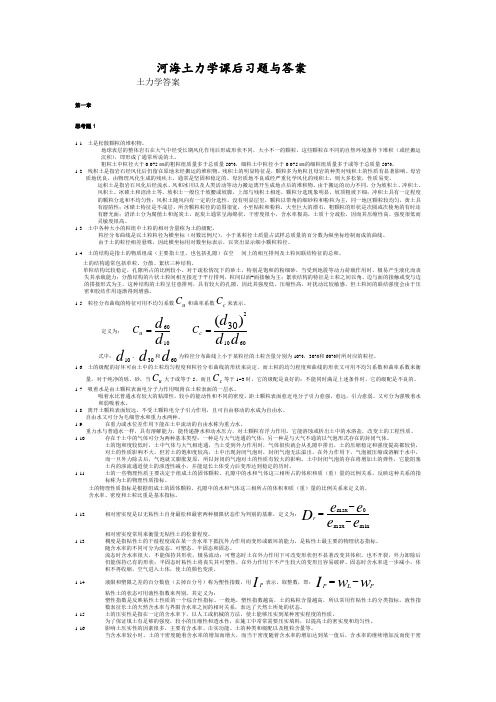
河海土力学课后习题与答案土力学答案第一章思考题11-1 土是松散颗粒的堆积物。
地球表层的整体岩石在大气中经受长期风化作用后形成形状不同,大小不一的颗粒,这些颗粒在不同的自然环境条件下堆积(或经搬运沉积),即形成了通常所说的土。
粗粒土中粒径大于0.075㎜的粗粒组质量多于总质量50%,细粒土中粒径小于0.075㎜的细粒组质量多于或等于总质量50%。
1-2 残积土是指岩石经风化后仍留在原地未经搬运的堆积物。
残积土的明显特征是,颗粒多为角粒且母岩的种类对残积土的性质有显著影响。
母岩质地优良,由物理风化生成的残疾土,通常是坚固和稳定的。
母岩质地不良或经严重化学风化的残积土,则大多松软,性质易变。
运积土是指岩石风化后经流水、风和冰川以及人类活动等动力搬运离开生成地点后的堆积物。
由于搬运的动力不同,分为坡积土、冲积土、风积土、冰碛土和沼泽土等。
坡积土一般位于坡腰或坡脚,上部与残积土相连,颗粒分选现象明显,坡顶粗坡下细;冲积土具有一定程度的颗粒分选和不均匀性;风积土随风向有一定的分选性,没有明显层里,颗粒以带角的细砂粒和粉粒为主,同一地区颗粒较均匀,黄土具有湿陷性;冰碛土特征是不成层,所含颗粒粒径的范围很宽,小至粘粒和粉粒,大至巨大的漂石,粗颗粒的形状是次圆或次棱角的有时还有磨光面;沼泽土分为腐植土和泥炭土,泥炭土通常呈海绵状,干密度很小,含水率极高,土质十分疏松,因而其压缩性高、强度很低而灵敏度很高。
1-3 土中各种大小的粒组中土粒的相对含量称为土的级配。
粒径分布曲线是以土粒粒径为横坐标(对数比例尺),小于某粒径土质量占试样总质量的百分数为纵坐标绘制而成的曲线。
由于土的粒径相差悬殊,因此横坐标用对数坐标表示,以突出显示细小颗粒粒径。
1-4 土的结构是指土的物质组成(主要指土里,也包括孔隙)在空间上的相互排列及土粒间联结特征的总和。
土的结构通常包括单粒、分散、絮状三种结构。
单粒结构比较稳定,孔隙所占的比例较小。
河海大学土力学试题

第一部分《土力学》习题弹I第一章土的物理性质型第二章土的渗透性及水的渗流迢I第三章土中应力和地基应力分布型第四章土的变形性质及地基沉降计算空I第五章土的抗剪强度浇j第六章天然地基承载力型第七章土压力型第八章土坡稳定第一章土的物理性质1. 土的三相比例指标包括:土粒比重、含水率、重度、孔隙比、孔隙率和饱和度,其中能够直验所取得的是哪三个?答:能够直接为试验所取得的是土粒比重,含水量,重度。
2.评价砂土和粘性土的物理指标分别有哪些?答:评价砂土的物理指标有孔隙比e、相对密实度D r和标准贯入试验击数N63.5评价粘性土的物理指标有最大干重度dmax、最优含水率op、压实系数c3 •有一种土样,孔隙率n 50%,土粒比重Gs 2.7,含水率是37%,则该土样处于何种状态).S r竺0.37 2" 1.0答:因为e n心n) 1, e 1,所以该土样属于饱和状态。
4.已知土粒的土粒比重Gs 2.70,含水率的孔隙率n 50%,贝吐匕时孔隙的体积为多少?30%,则10kN的土重中干土和水的重量各为多少解:W 10W s 7.7kN1 1 0.3W w 10 7.7 2.3kNW s7.7 3V s 0.285mG s w ,2.7 10n 亠,50% 3V v g/s 0.285m1 n 1 50%5.有一块50cm3的原状土样质量为95.15g,烘干后质量为75.05个,已知土粒比重Gs 2.67,求度、干重度d 、饱和重度sat 、浮重度 、天然含水率孔隙比e 、孔隙率n 、饱和度Sr ,并欢迎下载 3d sat '数值的大小。
解:土的天然重度 竺叮 19.03kN/m 350 10 6W s 土的干重度 575.05 10 3 ------------ 15.01kN / m 50 10 沁 100% 土的含水率 W s95.15 75.°5 100%75.05 26.78%sat土的饱和重度 (G s 1)G s (119.03 (2.67 1)2.67 (1 26.78%)10 19.39kN /m 3土的浮重度sat19.39 10 9.39kN /m 3 Gs w土的孔隙比2心 1 0.77915.01土的孔隙比en 二——1+e °.779 0.4381 0.779土的饱和度 S r 旦26・78% 2・6791.8%e0.779各种不同重度之间的关系为:sat > 6.某土坝施工时,土坝材料的土粒比重为 Gs 2.70,天然含水率为10%,上坝时的虚土干3d 12.7kN/m,要求碾压后饱和重度达到 95%,干重度达到16.8kN/m ,如每日填筑坝体500C每日上坝多少虚土?共需加多少水? 解:土的天然重度 d (1 w) 12.7 (1 10%) 13.97%当土的干重度达到316.8kN/m ,饱和度为95%时,由下式S;Sw[ s (1')]G sG s w (1')_13.97_2.7(——0.95 2.70 10(1 ) 13.97求得土的含水率96.78%第二章 土的渗透性及水的渗流1 •影响土的渗流性的因素主要有哪几种? 答:影响土的渗流性的因素主要有: ①土的粒度成分及矿物成分;②结合水膜的厚度;的粘滞度;⑤土中气体。
土力学河海大学第二版所有章节完整答案精
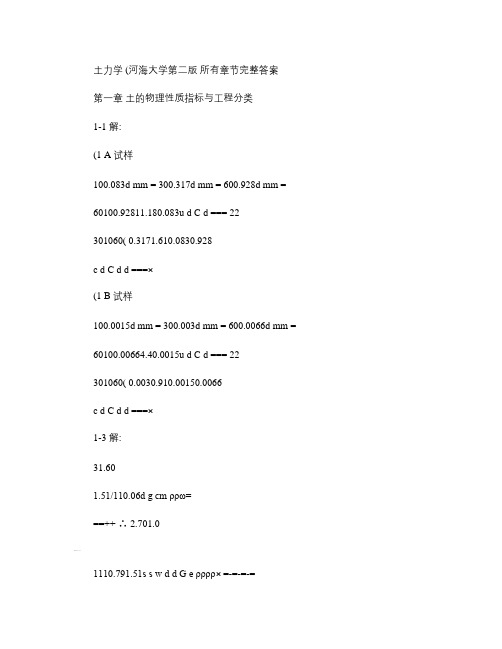
O、A、B点为0;
E点:kPa h w w 60 231(10=++⨯==γσ
绘图如下:
[2-3]甲乙两个基础,它们的尺寸和相对位置及每个基底下的基底净压力如图所示,求甲基础O点下2m处的竖向附加应力。
解:甲基础O点下2m处的竖向附加应力由基础甲、乙共同引起,计算中先分别计算甲、乙基础在该点引起的竖向附加应力,然后叠加。(1甲基础在O点下2m处引起的竖向附加应力:
1-5解:
(1 31.77
1.61/110.098d g cm w ρρ=
==++ ∴ 02.71.0
1110.681.61s s w d d G e ρρρρ⨯=-=-=-=
(2 00.68
25.2%2.7sat s e G ω===
(3 max 0max min 0.940.68
0.540.940.46
(1 B试样
100.0015d mm = 300.003d mm = 600.0066d mm =
60100.00664.40.0015u d C d === 22
301060( 0.0030.910.00150.0066
c d C d d ===⨯
1-3解:
31.60
1.51/110.06d g cm ρρω=
土力学(河海大学第二版所有章节完整答案
第一章土的物理性质指标与工程分类
1-1解:
(1 A试样
100.083d mm = 300.317d mm = 600.928d mm =
60100.92811.180.083u d C d === 22
301060( 0.3171.610.0830.928
河海大学复试土力学题土力学试卷(05答案)
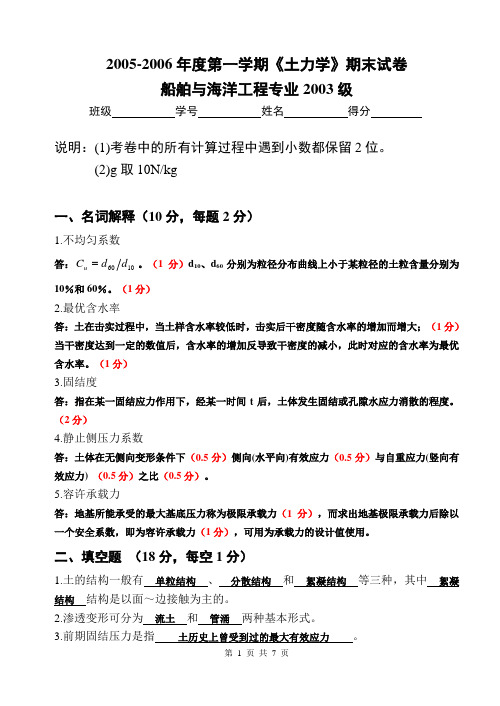
2005-2006年度第一学期《土力学》期末试卷船舶与海洋工程专业2003级班级 学号 姓名 得分说明:(1)考卷中的所有计算过程中遇到小数都保留2位。
(2)g 取10N/kg一、名词解释(10分,每题2分)1.不均匀系数 答:1060d d C u 。
(1分)d 10、d 60分别为粒径分布曲线上小于某粒径的土粒含量分别为10%和60%。
(1分)2.最优含水率答:土在击实过程中,当土样含水率较低时,击实后干密度随含水率的增加而增大;(1分)当干密度达到一定的数值后,含水率的增加反导致干密度的减小,此时对应的含水率为最优含水率。
(1分)3.固结度答:指在某一固结应力作用下,经某一时间t 后,土体发生固结或孔隙水应力消散的程度。
(2分)4.静止侧压力系数答:土体在无侧向变形条件下(0.5分)侧向(水平向)有效应力(0.5分)与自重应力(竖向有效应力) (0.5分)之比(0.5分)。
5.容许承载力答:地基所能承受的最大基底压力称为极限承载力(1分),而求出地基极限承载力后除以一个安全系数,即为容许承载力(1分),可用为承载力的设计值使用。
二、填空题 (18分,每空1分)1.土的结构一般有 单粒结构 、 分散结构 和 絮凝结构 等三种,其中 絮凝结构 结构是以面~边接触为主的。
2.渗透变形可分为 流土 和 管涌 两种基本形式。
3.前期固结压力是指 土历史上曾受到过的最大有效应力 。
4.根据莫尔-库伦破坏准则,当土体处于极限平衡状态时,则 莫尔应力圆 必然与 库伦抗剪强度线 相切。
根据几何关系,可以得到剪切破坏面与 大主应力面 的夹角为245ϕ+︒。
5、松砂受剪体积 减小 、紧砂受剪体积 增大 。
6、无粘性土土坡稳定的安全系数表示为αϕtg tg ;当有顺坡渗流逸出时,则为αγϕγtg tg sat '。
7、地基的破坏一般有 整体剪切破坏 、 局体剪切破坏 和 冲剪破坏 等三种型式。
三、选择题(20分,每题2分)1.土粒级配曲线越平缓,说明( C )A 、土粒均匀,级配不好;B 、土粒均匀,级配良好;C 、土粒不均匀,级配良好;D 、土粒不均匀,级配不好;2.土的三项通过试验测定的物理指标是( D )A 、天然重度、天然含水量和相对密度;B 、孔隙比、相对密度和密度;C 、孔隙比、天然含水量和饱和度;D 、含水率、密度和土粒比重;3.含水率的意义是:( C )A 、单位体积土体内所含水的质量;B 、单位孔隙体积内所含水的质量;C 、土中水的质量与土粒质量之比;D 、土中所含水的体积与土体总体积之比;4.有两个不同的基础,其基础总压力相同,在同一深度处,哪一个基础产生的附加应力大?( B )A 、宽度小的基础产生的附加应力大;B 、宽度小的基础产生的附加应力小;C 、宽度大的基础产生的附加应力小;D 、两个基础产生的附加应力相等;5.有一单面排水的土层在固结度达到0.5时所需要时间为4年,若将该土层改为双面排水,其固结度同样为0.5时所需时间为( A )A 、1年;B 、2年;C 、4年;D 、8年;6.超固结土是指土体:( B )A 、受到一超荷载;B 、当前有效应力小于前期固结压力;C 、固结压力超过了土体承受能力;D 、固结时间超过了预定;7.灵敏度是用来反映( A )的指标。
河海大学_土力学_课后习题答案

土力学答案第一章思考题11-1 土是松散颗粒的堆积物。
地球表层的整体岩石在大气中经受长期风化作用后形成形状不同,大小不一的颗粒,这些颗粒在不同的自然环境条件下堆积(或经搬运沉积),即形成了通常所说的土。
粗粒土中粒径大于0.075㎜的粗粒组质量多于总质量50%,细粒土中粒径小于0.075㎜的细粒组质量多于或等于总质量50%。
1-2 残积土是指岩石经风化后仍留在原地未经搬运的堆积物。
残积土的明显特征是,颗粒多为角粒且母岩的种类对残积土的性质有显著影响。
母岩质地优良,由物理风化生成的残疾土,通常是坚固和稳定的。
母岩质地不良或经严重化学风化的残积土,则大多松软,性质易变。
运积土是指岩石风化后经流水、风和冰川以及人类活动等动力搬运离开生成地点后的堆积物。
由于搬运的动力不同,分为坡积土、冲积土、风积土、冰碛土和沼泽土等。
坡积土一般位于坡腰或坡脚,上部与残积土相连,颗粒分选现象明显,坡顶粗坡下细;冲积土具有一定程度的颗粒分选和不均匀性;风积土随风向有一定的分选性,没有明显层里,颗粒以带角的细砂粒和粉粒为主,同一地区颗粒较均匀,黄土具有湿陷性;冰碛土特征是不成层,所含颗粒粒径的范围很宽,小至粘粒和粉粒,大至巨大的漂石,粗颗粒的形状是次圆或次棱角的有时还有磨光面;沼泽土分为腐植土和泥炭土,泥炭土通常呈海绵状,干密度很小,含水率极高,土质十分疏松,因而其压缩性高、强度很低而灵敏度很高。
1-3 土中各种大小的粒组中土粒的相对含量称为土的级配。
粒径分布曲线是以土粒粒径为横坐标(对数比例尺),小于某粒径土质量占试样总质量的百分数为纵坐标绘制而成的曲线。
由于土的粒径相差悬殊,因此横坐标用对数坐标表示,以突出显示细小颗粒粒径。
1-4 土的结构是指土的物质组成(主要指土里,也包括孔隙)在空间上的相互排列及土粒间联结特征的总和。
土的结构通常包括单粒、分散、絮状三种结构。
单粒结构比较稳定,孔隙所占的比例较小。
对于疏松情况下的砂土,特别是饱和的粉细砂,当受到地震等动力荷载作用时,极易产生液化而丧失其承载能力;分散结构的片状土粒间相互接近于平行排列,粒间以面-面接触为主;絮状结构的特征是土粒之间以角、边与面的接触或变与边的搭接形式为主,这种结构的土粒呈任意排列,具有较大的孔隙,因此其强度低,压缩性高,对扰动比较敏感,但土粒间的联结强度会由于压密和胶结作用逐渐得到增强。
河海大学_土力学_课后习题思考题答案
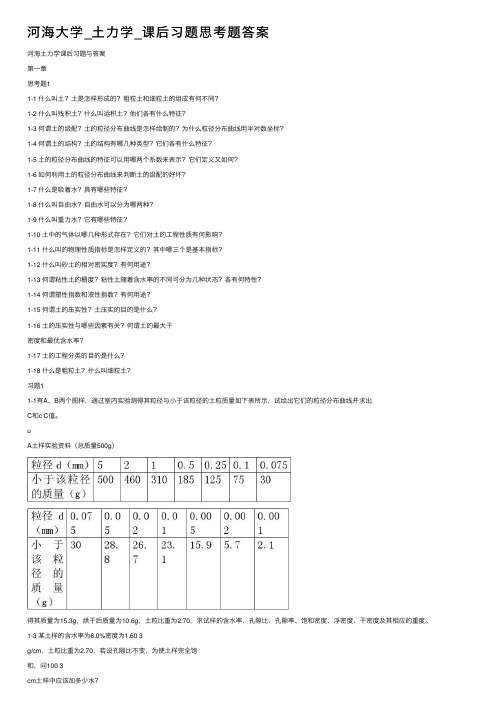
河海⼤学_⼟⼒学_课后习题思考题答案河海⼟⼒学课后习题与答案第⼀章思考题11-1 什么叫⼟?⼟是怎样形成的?粗粒⼟和细粒⼟的组成有何不同?1-2 什么叫残积⼟?什么叫运积⼟?他们各有什么特征?1-3 何谓⼟的级配?⼟的粒径分布曲线是怎样绘制的?为什么粒径分布曲线⽤半对数坐标?1-4 何谓⼟的结构?⼟的结构有哪⼏种类型?它们各有什么特征?1-5 ⼟的粒径分布曲线的特征可以⽤哪两个系数来表⽰?它们定义⼜如何?1-6 如何利⽤⼟的粒径分布曲线来判断⼟的级配的好坏?1-7 什么是吸着⽔?具有哪些特征?1-8 什么叫⾃由⽔?⾃由⽔可以分为哪两种?1-9 什么叫重⼒⽔?它有哪些特征?1-10 ⼟中的⽓体以哪⼏种形式存在?它们对⼟的⼯程性质有何影响?1-11 什么叫的物理性质指标是怎样定义的?其中哪三个是基本指标?1-12 什么叫砂⼟的相对密实度?有何⽤途?1-13 何谓粘性⼟的稠度?粘性⼟随着含⽔率的不同可分为⼏种状态?各有何特性?1-14 何谓塑性指数和液性指数?有何⽤途?1-15 何谓⼟的压实性?⼟压实的⽬的是什么?1-16 ⼟的压实性与哪些因素有关?何谓⼟的最⼤⼲密度和最优含⽔率?1-17 ⼟的⼯程分类的⽬的是什么?1-18 什么是粗粒⼟?什么叫细粒⼟?习题11-1有A、B两个图样,通过室内实验测得其粒径与⼩于该粒径的⼟粒质量如下表所⽰,试绘出它们的粒径分布曲线并求出C和c C值。
uA⼟样实验资料(总质量500g)得其质量为15.3g,烘⼲后质量为10.6g,⼟粒⽐重为2.70,求试样的含⽔率、孔隙⽐、孔隙率、饱和密度、浮密度、⼲密度及其相应的重度。
1-3 某⼟样的含⽔率为6.0%密度为1.60 3g/cm,⼟粒⽐重为2.70,若设孔隙⽐不变,为使⼟样完全饱和,问100 3cm⼟样中应该加多少⽔?1-4 有⼟料1000g,它的含⽔率为6.0%,若使它的含⽔率增加到16.0%,问需要加多少⽔?1-5 有⼀砂⼟层,测得其天然密度为1.773g/cm ,天然含⽔率为9.8%,⼟的⽐重为2.70,烘⼲后测得最⼩孔隙⽐为0.46,最⼤孔隙⽐为0.94,试求天然孔隙⽐e 、饱和含⽔率和相对密实度D ,并判别该砂⼟层处于何种密实状态。
河海大学复试土力学资料

河海大学复试土力学资料————————————————————————————————作者:————————————————————————————————日期:一、简答与简述题1 .土的级配不连续是什么含义?其粒径分布曲线和粒组频率曲线各有什么特征?(6分)答:土中各种大小的粒组土粒的相对含量称为土的级配(考虑加分)土的级配不连续是指土中缺乏某种或某几种中间粒径的粒组(2分)土的级配的好坏可由土中的土粒均匀程度和粒径分布曲线(半对数坐标系)的形状来决定,而土粒的均匀程度和曲线的形状又可用不均匀系数和曲率系数来衡量。
颗粒级配分布曲线:水平段(台阶)——缺乏某些粒径——级配不连续(2分)坡度渐变——大小连续——连续级配;曲线形状平缓——粒径变化范围大——不均匀——良好;曲线形状较陡——变化范围小——均匀——不良(考虑加分)粒组频率曲线为双峰且谷点<3%,级配不连续(2分)(考虑加分)定量判别:(1)不均匀系数6010 ud Cd=(2)曲率系数2306010 cdCd d=603010d d d分别表示级配曲线上纵坐标为60% 30% 10%时对应粒径2. 粘性土有那几种状态?各状态之间是通过什么来区分的?(6分)答:固体、半固体、可塑、流动四种状态。
(说三种也可)(3分)一般用稠度来描述粘性土的干湿程度(状态)反映在某一含水率下抵抗外力作用而变形或破坏的能力。
(可考虑加分) 各状态的区分如下:液限(W L )——从流动状态转变为可塑状态的界限含水率,也就是可塑状态的上限含水率;(1分)塑限(Wp )——从可塑状态转变为半固体状态的界限含水率,也就是可塑状态的下限含水率;(1分)缩限(Ws )——从半固体状态转变为固体状态的界限含水率,亦即粘性土随着含水率的减小而体积开始不变时的含水率。
(1分)3. 什么是前期固结压力?什么样的土为欠固结土?欠固结土层中一定存在超静孔隙水应力吗?欠固结土层上如不施加新的压力,土层也会继续压缩吗?为什么?(6分) 答:前期固结压力为土在历史上受到的最大有效应力,用Pc 表示。
河海大学土力学试题库及答案

河海大学土力学试题库及答案第1章 土的物理性质与工程分类一.填空题1. 颗粒级配曲线越平缓,不均匀系数越大,颗粒级配越好。
为获得较大密实度,应选择级配良好的土料作为填方或砂垫层的土料。
2. 粘粒含量越多,颗粒粒径越小,比表面积越大,亲水性越强,可吸附弱结合水的含量越多,粘土的塑性指标越大 3. 塑性指标p L p w w I -=,它表明粘性土处于可塑状态时含水量的变化范围,它综合反映了粘性、可塑性等因素。
因此《规范》规定:1710≤<p I 为粉质粘土,17>p I 为粘土。
4. 对无粘性土,工程性质影响最大的是土的密实度,工程上用指标e 、r D 来衡量。
5. 在粘性土的物理指标中,对粘性土的性质影响较大的指标是塑性指数p I 。
6. 决定无粘性土工程性质的好坏是无粘性土的相对密度,它是用指标r D 来衡量。
7. 粘性土的液性指标pL p L w w w w I --=,它的正负、大小表征了粘性土的软硬状态,《规范》按L I 将粘性土的状态划分为坚硬、硬塑、可塑、软塑、流塑。
8. 岩石按风化程度划分为微风化、中等风化、强风化。
9. 岩石按坚固程度划分为硬质岩石,包括花岗岩、石灰岩等;软质岩石,包括页岩、泥岩等。
10.某砂层天然饱和重度20=sat γkN/m 3,土粒比重68.2=s G ,并测得该砂土的最大干重度1.17max =d γkN/m 3,最小干重度4.15min =d γkN/m 3,则天然孔隙比e 为0.68,最大孔隙比=max e 0.74,最小孔隙比=min e 0.57。
11.砂粒粒径范围是0.075~2mm ,砂土是指大于2mm 粒径累计含量不超过全重50%,而大于0.075mm 粒径累计含量超过全重50%。
12.亲水性最强的粘土矿物是蒙脱石,这是因为它的晶体单元由两个硅片中间夹一个铝片组成,晶胞间露出的是多余的负电荷,因而晶胞单元间联接很弱,水分子容易进入晶胞之间,而发生膨胀。
SoilMechFinalReview201011
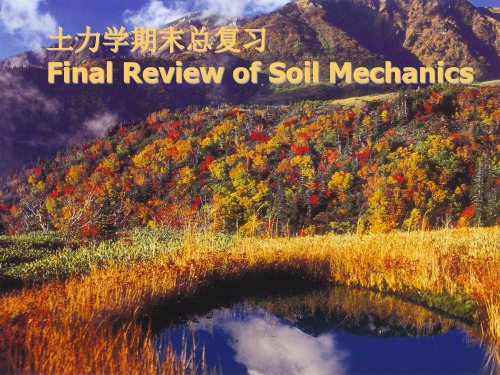
K of soil layers 层状地基的等效渗透系数
渗透力: 概念与计算
渗透变形: 类型,条件,防治
2 WATER FLOW THROUGH SOIL
2.1 Introduction
2.2 Driving Potential - Total Head 2.3 Darcy’s Law 2.4 Determination of the Coefficient of Permeability
CD,CU,UU
§3.6 应力路径与极限状态概念
最大剪应力
CHAPTER 4 STRESSES IN SOIL
4.1 Introduction 4.2 Effective Overburden Pressure
in the Ground 4.3 Contact Pressure between the
3.3 土的抗剪强度特征
强度指标: 粘聚力 c 内摩擦角
总应力强度指标 与
有效应力强度指标
直剪强度指标 与
三轴试验强度指标
三种分 类方法
峰值强度指标 与
残余强度指标
目的
工程应用
3 Shear strength 3.5 Shear Strength Characteristics
二. 三轴试验强度指标
§1 Properties of soil §1.2 components of soil 1.2.1 Solid Phase
小于某粒径之土质量百分数P(%) 10 5.0 1.0 0.5
0.10 0.05 0.01 0.005 0.001
10 5.0 2.0 1.0 0.5 0.25 0.1
土力学(河海大学第二版)所有章节完整课后习题答案
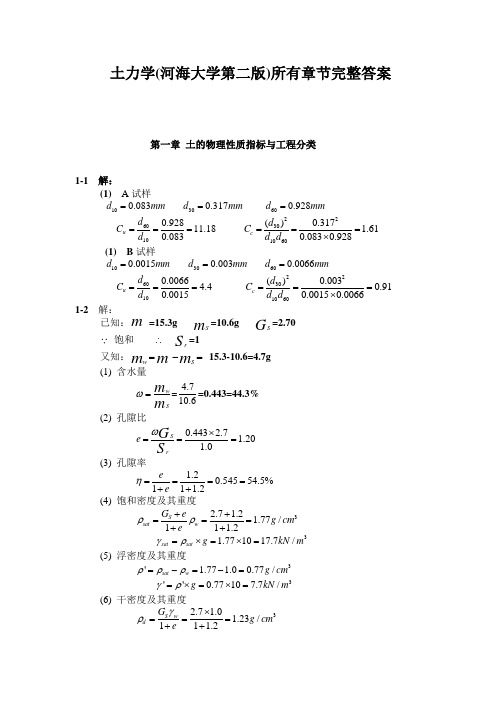
土力学(河海大学第二版)所有章节完整答案第一章 土的物理性质指标与工程分类1-1 解:(1) A 试样100.083d mm = 300.317d mm = 600.928d mm =60100.92811.180.083u d C d === 22301060()0.317 1.610.0830.928c d C d d ===⨯ (1) B 试样100.0015d mm = 300.003d mm = 600.0066d mm =60100.0066 4.40.0015u d C d === 22301060()0.0030.910.00150.0066c d C d d ===⨯ 1-2 解:已知:m =15.3g S m =10.6g S G =2.70饱和 ∴r S =1又知:wSm m m =-= 15.3-10.6=4.7g(1) 含水量 w Sm mω==4.710.6=0.443=44.3% (2) 孔隙比 0.443 2.71.201.0Sre G Sω⨯===(3) 孔隙率1.20.54554.5%11 1.2e e η====++ (4) 饱和密度及其重度32.7 1.21.77/11 1.2Ssat w G e g cm e ρρ++===++ 31.771017.7/sat sat g kN m γρ=⨯=⨯=(5) 浮密度及其重度3' 1.77 1.00.77/sat w g cm ρρρ=-=-= 3''0.77107.7/g kN m γρ=⨯=⨯= (6) 干密度及其重度32.7 1.01.23/11 1.2S w d G g cm e γρ⨯===++31.231012.3/d d g kN m γρ=⨯=⨯= 1-3 解:31.601.51/110.06d g cm ρρω===++ ∴ 2.70 1.01110.791.51s s w d d G e ρρρρ⨯=-=-=-= ∴ 0.7929.3%2.70sat s e G ω===1.60100150.91110.06s m V m g ρωω⨯====+++∴ (29.3%6%)150.935.2w s m m g ω∆=∆=-⨯=1-4 解:w Sm mω=w Sm m m =-sSm m mω=-∴ 1000940110.06s m m g ω===++0.16ω∆=∴ 0.16940150w s m m g ω∆=∆=⨯=1-5 解:(1)31.771.61/110.098d g cm w ρρ===++∴ 0 2.7 1.01110.681.61s s w d d G e ρρρρ⨯=-=-=-= (2) 00.6825.2%2.7sat s e G ω=== (3) max 0max min 0.940.680.540.940.46r e e D e e --===--1/32/3r D <<∴ 该砂土层处于中密状态。
河海大学土力学知识点(最终得91分)
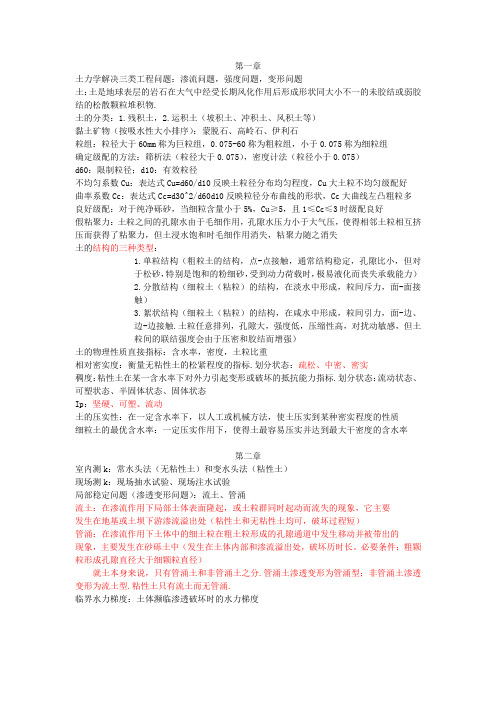
土力学解决三类工程问题:渗流问题,强度问题,变形问题土:土是地球表层的岩石在大气中经受长期风化作用后形成形状同大小不一的未胶结或弱胶结的松散颗粒堆积物.土的分类:1.残积土,2.运积土(坡积土、冲积土、风积土等)黏土矿物(按吸水性大小排序):蒙脱石、高岭石、伊利石粒组:粒径大于60mm称为巨粒组,0.075-60称为粗粒组,小于0.075称为细粒组确定级配的方法:筛析法(粒径大于0.075),密度计法(粒径小于0.075)d60:限制粒径;d10:有效粒径不均匀系数Cu:表达式Cu=d60/d10反映土粒径分布均匀程度,Cu大土粒不均匀级配好曲率系数Cc:表达式Cc=d30^2/d60d10反映粒径分布曲线的形状,Cc大曲线左凸粗粒多良好级配:对于纯净砾砂,当细粒含量小于5%,Cu≥5,且1≤Cc≤3时级配良好假粘聚力:土粒之间的孔隙水由于毛细作用,孔隙水压力小于大气压,使得相邻土粒相互挤压而获得了粘聚力,但土浸水饱和时毛细作用消失,粘聚力随之消失土的结构的三种类型:1.单粒结构(粗粒土的结构,点-点接触,通常结构稳定,孔隙比小,但对于松砂,特别是饱和的粉细砂,受到动力荷载时,极易液化而丧失承载能力)2.分散结构(细粒土(粘粒)的结构,在淡水中形成,粒间斥力,面-面接触)3.絮状结构(细粒土(粘粒)的结构,在咸水中形成,粒间引力,面-边、边-边接触.土粒任意排列,孔隙大,强度低,压缩性高,对扰动敏感,但土粒间的联结强度会由于压密和胶结而增强)土的物理性质直接指标:含水率,密度,土粒比重相对密实度:衡量无粘性土的松紧程度的指标.划分状态:疏松、中密、密实稠度:粘性土在某一含水率下对外力引起变形或破坏的抵抗能力指标.划分状态:流动状态、可塑状态、半固体状态、固体状态Ip:坚硬、可塑、流动土的压实性:在一定含水率下,以人工或机械方法,使土压实到某种密实程度的性质细粒土的最优含水率:一定压实作用下,使得土最容易压实并达到最大干密度的含水率第二章室内测k:常水头法(无粘性土)和变水头法(粘性土)现场测k:现场抽水试验、现场注水试验局部稳定问题(渗透变形问题):流土、管涌流土:在渗流作用下局部土体表面隆起,或土粒群同时起动而流失的现象,它主要发生在地基或土坝下游渗流溢出处(粘性土和无粘性土均可,破坏过程短)管涌:在渗流作用下土体中的细土粒在粗土粒形成的孔隙通道中发生移动并被带出的现象,主要发生在砂砾土中(发生在土体内部和渗流溢出处,破坏历时长。
土力学河海大学第三版课后习题答案

土力学河海大学第三版课后习题答案Chapter 1: 土的性质和分类1.1 土力学的定义土力学是研究土体在外力作用下物理力学性质的学科,包括了土体的性质、分类和力学性质等方面。
1.2 土的组成和性质土的主要组成成分有固体颗粒、水和空气。
固体颗粒主要有砂粒、粉粒和黏粒。
土的性质包括颗粒大小、颗粒的形状、颗粒的强度和颗粒间的摩擦角等。
1.3 土的分类根据土的颗粒大小将土分为砂土、粉土和黏土。
砂土颗粒大小在0.05mm-2mm之间,粉土颗粒大小在0.002mm-0.05mm之间,黏土颗粒大小小于0.002mm。
1.4 土质的影响因素土质的影响因素有颗粒大小、颗粒形状、颗粒强度、颗粒内摩擦角、颗粒间摩擦角等。
这些因素决定了土质的力学性质,如强度、压缩性、渗透性等。
Chapter 2: 土的压缩性和渗透性2.1 土的压缩性土的压缩性是指土在受到外力压缩时的体积变化性质。
土的压缩性主要包括压缩指数、压缩变形和压缩曲线等。
2.2 土的渗透性土的渗透性是指土体中水分移动的能力。
土的渗透性受到土的孔隙结构和土的颗粒特性的影响。
常用的衡量土的渗透性的指标有渗透系数和渗透曲线。
Chapter 3: 土的剪切行为3.1 土的剪切强度土的剪切强度是指土体在剪切力作用下抵抗变形的能力。
常用的剪切强度指标有内摩擦角和剪切强度参数等。
3.2 剪切试验剪切试验是用来测定土体的剪切强度和确定剪切曲线的一种试验。
常用的剪切试验方法有直剪试验和三轴剪切试验。
3.3 剪切带剪切带是指在土体剪切过程中形成的裂缝。
剪切带的形成与土体的剪切强度、土的性质和剪切应力等因素有关。
Chapter 4: 土的变形和应力状态4.1 土的变形土体在受到外力作用下会发生变形。
土体的变形包括弹性变形和塑性变形。
弹性变形是可回复的,塑性变形是不可回复的。
4.2 应力状态应力状态是指土体中各个点所受到的应力,包括垂向应力和切向应力。
常用的应力状态有均匀应力状态和非均匀应力状态。
土力学第一章河海大学

粘土矿物-同像置换
§1.2 土的三相组成 – 固体颗粒
原生矿物:一般颗粒较粗,呈粒状。 有圆状、浑圆状、棱角状等。
次生矿物:颗粒较细,多呈针状、片 状、扁平状。
比表面积:单位质量土颗粒所拥有的 总表面积。对于粘性土,其大小直接 反映土颗粒与四周介质,特别是水,相 互作用的强烈程度,是代表粘性土特征 的一个很重要的指标。 高岭石的比表面积为:10-20m2/g,伊 利石:80-l00m2/g,蒙特石:800m2/g
粘土矿物
§1.2 土的三相组成 – 固体颗粒
依硅片和铝片组叠 形式的不同,可分 成如下三种类型:
Al Si Si
高岭 石微粒
Al Al Si Si Al Al Si Si
• 长石风化的产物
• 晶层间通过氢键联结,联结力强,晶 格不能自由活动,水难以进入晶格间
• 内容琐碎、零散
• 理清各节间联系 • 理清各节内层次 • 注意物理概念的把握
土的形成过程
土的三相组成 土的物理状态 决定 土的结构
渗透特性 变形特性 强度特性
土的工程分类:便于研究和应用 土的压实性:如何获得较好的土
第一章:土的物理性质与工程分类
§1.1 §1.2 §1.3 §1.4 §1.5 §1.6
依硅片和铝片组叠 形式的不同,可分 成如下三种类型:
2:1的三 层结构
Si Si Al Al Si Si
数层 水分子
Si Si Al Al Si Si
高岭石 蒙脱石 伊利石
粘土矿物
• 是伊利石进一步风化或火山灰风化而 成的产物
• 晶层间是O2-对O2-的连结,联结力很 弱,水很容易进入晶层之间。
河海大学土力学英文教案Chapter 2 Permeability of Soil
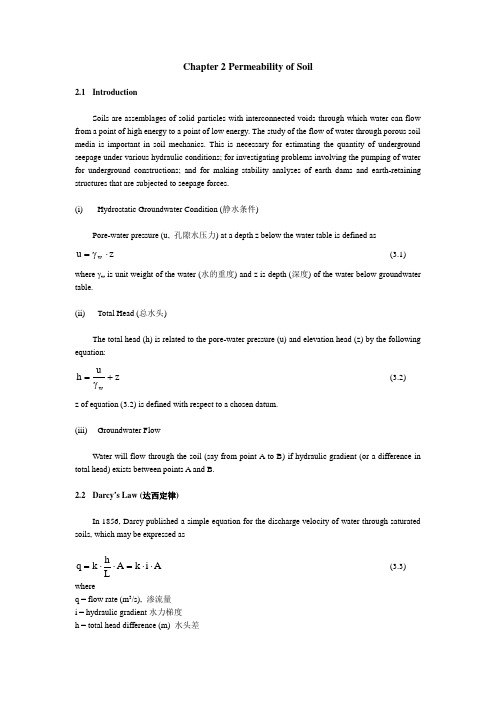
Chapter 2 Permeability of Soil2.1 IntroductionSoils are assemblages of solid particles with interconnected voids through which water can flow from a point of high energy to a point of low energy. The study of the flow of water through porous soil media is important in soil mechanics. This is necessary for estimating the quantity of underground seepage under various hydraulic conditions; for investigating problems involving the pumping of water for underground constructions; and for making stability analyses of earth dams and earth-retaining structures that are subjected to seepage forces. (i) Hydrostatic Groundwater Condition (静水条件)Pore-water pressure (u, 孔隙水压力) at a depth z below the water table is defined as z u w ⋅γ=(3.1)where γw is unit weight of the water (水的重度) and z is depth (深度) of the water below groundwatertable. (ii) Total Head (总水头)The total head (h) is related to the pore-water pressure (u) and elevation head (z) by the followingequation:z uh w+γ=(3.2)z of equation (3.2) is defined with respect to a chosen datum.(iii) Groundwater FlowWater will flow through the soil (say from point A to B) if hydraulic gradient (or a difference in total head) exists between points A and B.2.2 Darcy ’s Law (达西定律)In 1856, Darcy published a simple equation for the discharge velocity of water through saturated soils, which may be expressed asA i k A Lhk q ⋅⋅=⋅⋅= (3.3)whereq = flow rate (m 3/s), 渗流量 i = hydraulic gradient 水力梯度 h = total head difference (m) 水头差L = length of flow (m) 渗径长度k = coefficient of permeability (m/s) 渗透系数 A = cross-sectional area of the specimen (m 2) 横截面积Equation (3.3) implies that the flow rate (q) bears a linear relationship to the hydraulic gradient (i). However, a non-linear relationship between q and i is found for clay [叁考: 土力学 p.69 图 3-3]. For practical reason, the following relationship between q and i is assumed for clay:()A i i k q b ⋅-⋅=(3.3a)where i b is starting hydraulic gradient (起始水力梯度). For gravelly soil (砾土), linear relationship between q and i appears at small hydraulic gradient only. As hydraulic gradient increases beyond a critical value, the relationship becomes non-linear as the flow becomes turbulent (紊流) [叁考: 土力学 p.69 图 3-3].Darcy ’s law is valid for laminar flow (层流) condition where Reynolds numbers is smaller than or equal to 1. Reynolds numbers (雷诺数) is defined as follows:1dv Re ≤η⋅⋅ρ=(3.4)where ρ is density of water (水的密度), v is velocity of water (流速), η is viscosity of water (水的粘滞系数) and d is average diameter of soil grains (土粒子平均粒径). As ρ = 1 g/cm 3, v = 0.25 cm/s, η = 0.0131 g/s ⋅cm at temperature of 10︒C, d is calculated by equation (3.4)m m 52.0v0.1d ≤⋅ρη⋅≤Thus Darcy ’s law can be applied to soils which are finer than coarse sand.2.3 Determination of Coefficient of Permeability (渗透系数的测定)2.3.1Constant head test (常水头测试)A typical arrangement of the constant head permeability test is shown in Fig.2.1. In the setup, the total water head is always maintained constant during the period of the test. The constant head test is suitable for coarse-grained soils. The coefficient of permeability is calculated by the following equation:t h A LV Lh t A V i v k ⋅∆⋅⋅=∆⋅== (3.5)where V is volume of water collected, L is length of the specimen, A is cross-sectional area of the specimen, ∆h is total head difference and t is duration of the test.2.3.2 Falling Head Test (变水头测试)A typical arrangement of the falling head permeability test is shown in Fig.2.2. It is suitable for fine-grained soils. The rate of flow of water through the specimen at any time t is given bydtdhA A L h k dt dV 21⋅-=⋅⋅= (3.6a)where V is volume of water collected, L is length of the specimen, A 1 is cross-sectional area of the specimen, A 2 is cross-sectional area of the standpipe and h is total head difference. Re-arranging equation (3.6a) into⎪⎭⎫⎝⎛-⋅⋅=h dh k A L A dt 12(3.6b)Integrating equation (3.6b)⎪⎭⎫⎝⎛-⋅⋅⋅=⎰⎰h dh k A L A dt 21h h 12T⎪⎪⎭⎫ ⎝⎛⋅⋅⋅=2112h h ln k A L A T ⎪⎪⎭⎫ ⎝⎛⋅⋅⋅=2112h h ln T A L A k(3.6c)The values of k for different types of soil are typically within the ranges shown in Table 2.1.2.4 Seepage and Flow Nets (渗流和流网)2.4.1 Laplace ’s equationLaplace differential equation of continuity is used to describe the two-dimensional steady flow condition for a given point in the soil mass. Let us consider a soil element as shown in Fig. 2.3. The element has dimension of dx and dz in x and z direction, respectively. Water flows through the element due to a hydraulic head difference between upstream and downstream side. Let v x and v z be the discharge velocity in the x and z direction, respectively. The rates of flow of water into the element in the x and z direction are1dz v q x )in (x ⋅⋅= (3.7a) 1dx v q z )in (z ⋅⋅=(3.7b)The rates of flow of water out of the element in the x and z direction are1dz dx x v v q x x )out (x ⋅⋅⎪⎭⎫⎝⎛∂∂+=(3.7c)1dx dz z v v q z z )out (z ⋅⋅⎪⎭⎫⎝⎛∂∂+=(3.7d)Assuming water is incompressible and no volume change in the soil mass occurs, the total rate of inflow should be equal to the total rate of outflow1dx v 1dz v 1dx dz z v v 1dz dx x v v z x z z x x ⋅⋅+⋅⋅=⋅⋅⎪⎭⎫⎝⎛∂∂++⋅⋅⎪⎭⎫ ⎝⎛∂∂+0zv x v z x =∂∂+∂∂(3.7e)Using Darcy ’s law, v x and v z can be expressed asx hk i k v x x x x ∂∂⋅=⋅= (3.7f) z h k i k v z z z z ∂∂⋅=⋅=(3.7g)Substituting equations (3.7f) and (3.7g) into equation (3.7e)0zhk x h k 22z 22x =∂∂⋅+∂∂⋅(3.7h)If the soil is isotropic k x = k z , equation (3.7h) becomes0z h x h 2222=∂∂+∂∂ (3.7i)2.4.2 Flow NetsThe continuity equation [equation(3.7i)] in isotropic medium represents two orthogonal families of curves – that is, the flow lines (流线) and equipotential lines (等势线).A flow line is a line along which a water particle will travel from upstream to the downstream side in the permeable soil medium. An equipotential line is a line along which the total head (总水头) at all points is the same. If piezometers (测压计) are placed at different points along an equipotential line, the height of water will rise to the same elevation in all of them. A combination of a number of flow lines and equipotential lines is called a flow net.To complete the graphical construction of a flow net, the flow and equipotential lines are drawn in such a way that (i) the equipotential lines intersect the flow lines at right angle, (ii) the flow elements are approximate squares, (iii) the upstream and downstream surfaces of the permeable layer are equipotential lines and (iv) the boundary of the impervous layer is a flow line.Based on the flow net, the total flow rate (q) can be estimated bydfN N H k q ⋅⋅= (3.8)where H is the total head difference between the upstream and downstream sides, N f is the number of flow channels and N d is the number of equipotential drops.In addition, the pore-water pressure (u) at a given point A determined from the flow net is⎪⎪⎭⎫ ⎝⎛⋅-=d dt Nn H H h (3.9a)()w e t h h u γ⋅-=(3.9b)where H is total head difference, N d is total number of equipotential drops, n d is number of equipotential drops at point A, h t is total head at point A and h e is elevation head at point A.2.5 Effective stress (有效应力)2.5.1 Effective stress principleEffective stress (σ’) is defined asAN 's∑=σ (3.10a)where ∑N s is the sum of inter-contact forces and A is the cross-sectional area of the soil mass under consideration.Total stress (σ) is defined as()u A A N A s s ⋅-+=⋅σ∑()u AA A AN s s⋅-+=σ∑(3.10b)where A s is cross-sectional area of the soil mass occupied by solid-to-solid contacts. As the ratio A s /A is small and can be neglected for pressure ranges encountered in practical problems. Thus, equation (3.10b) becomesu '+σ=σ(3.11)2.5.2 Pore-water pressure and effective stress under hydrostatic conditionThe total stress at depth z isz sat ⋅γ=σ(3.12a)The pore-water pressure at depth z isz u w ⋅γ=(3.12b)The effective stress at depth z is()z 'z u 'w sat ⋅γ=⋅γ-γ=-σ=σ(3.12c)where γsat is saturated unit weight of soil, γw is unit weight of water and γ’ is submerged unit weight ofsoil.2.5.3 Pore-water pressure and effective stress under seepage(i) Downward seepageThe pore-water pressure at depth z is reduced because of the downward flow of waterh z u w w ⋅γ-⋅γ=(3.13a)where h is the hydraulic head difference between ground surface and depth z. The effective stress at depth z becomesh z 'u 'w ⋅γ+⋅γ=-σ=σ(3.13b)(ii) Upward seepageThe pore-water pressure at depth z is increased because of the upward flow of waterh z u w w ⋅γ+⋅γ=(3.14a)where h is the hydraulic head difference between ground surface and depth z. The effective stress at depth z becomesh z 'u 'w ⋅γ-⋅γ=-σ=σ(3.14b)2.5.4 Critical hydraulic gradient (临界水力梯度)At boiling or quick condition under a critical hydraulic gradient (i c ), the weight of the soil will be balanced by the upward seepage force such that the effective stress becomes zero. From equation (3.14b)0h z 'c w =⋅γ-⋅γ()()()n 11G e11G 'z h i s s w c c -⋅-=+-=γγ==(3.15)where e is void ratio and n is porosity.Table 2.1 Typical values of coefficients of permeability (k)Key wordsClay粘土Constant head test 常水头测试Cross-sectional area 横截面积Darcy’s Law 达西定律Density 密度Diameter of soil grains 土粒子粒径Discharge velocity 渗透速度Effective Stress有效应力Equipotential line 等势线Falling head test 变水头测试Flow line 流线Flow net 流网Flow rate 渗流量Gravel 砾石Hydraulic Head 水头Hydraulic head difference 水头差Hydraulic gradient 水力梯度Breaking hydraulic gradient起始水力梯度Critical hydraulic gradient 临界水力梯度Hydrostatic condition静水条件Laminar flow 层流Laplace Equation 拉普拉斯方程Mixture混合物Permeability 渗透性Coefficient of permeability 渗透系数Pore-water pressure孔隙水压力Porosity 孔隙率Reynolds numbers 雷诺数Sand 砂土Seepage 渗流Seepage Force渗流力Silt 粉土Total Stress总应力Turbulent flow 紊流Viscosity 粘滞系数V oid ratio 孔隙比Fig. 2.1 Setup of constant head permeability test Fig. 2.2 Setup of falling head permeability test Fig. 2.3 Seepage through a soil elementChapter 3 Stresses in soil (土体应力)3.1 IntroductionSoil mass can bear loadings from structures as well as its self-weight. Stresses are produced due to these loadings. The stresses are used to evaluate the deformation of the structures founded on the soil mass and the stability of the soil mass. This chapter presents the methods to determine the self weight and additional stresses acted on a soil mass.3.2 In-situ stresses (原位应力)3.2.1 Effective vertical stress (竖向应力)The effective vertical stress (σ’z ) is calculated from the unit weight of the soil (土的重度),γ.(i) No ground water table (地下水位) exists [叁考: 土力学 p.39 图 2-1]z 'z ⋅γ=σ(3.1)where γ (kN/m 3) is unit weight of the soil and z (m) is depth of the soil.(ii) Ground water table locates at the ground surface()z 'z 'w z ⋅γ=⋅γ-γ=σ(3.2)where γ’ (kN/m 3) is submerged unit weight of the soil (土的浮重度) and γw (9.81 kN/m 3) is unit weightof water (水的浮重度).(iii) If the ground consists of n different layers of stratum (土层)i n1i i z z '⋅γ=σ∑=(3.3)where γi and z i are unit weight and depth of the soil of the i th stratum, respectively.3.2.2 Effective horizontal stress (侧向应力)The effective horizontal stress (σ’h ) is much more difficult to be evaluated. Normally, the horizontal stress is expressed as a function vertical stress by the following expression:v o h 'K 'σ⋅=σ(3.4)where K o is coefficient of earth pressure at rest (静止侧压力系数). Typical values of K o are listed inTable 3.1.3.3 Contact pressures at the bottom of the foundation (基底压力)3.3.1 Flexible and rigid foundationsThe pressure distribution beneath a foundation depends on the type of load, the flexural rigidity of the foundation and the type of material on which it is resting.A flexible foundation (柔性基础) has zero stiffness but a rigid foundation (刚性基础) has infinite stiffness. A uniformly loaded flexible foundations (e.g. oil tank and earth dam) resting on an elastic material such as saturated clay will take a sagging profile and the contact pressure is also uniformly distributed [叁考: 土力学 p.41 图 2-4].A rigid foundation (e.g. concrete dam, box foundation) resting on saturated clay will undergo uniform settlement and the contact pressure distribution looks like a saddle, i.e. large at the edge but small in the middle [叁考: 土力学 p.42 图 2-5].If the size of the foundation is not too large and the applied load is small, linear distribution of the contact pressure can be used.3.3.2 Pressure distribution at the bottom of the rigid foundation(i) Vertical load at the center of the foundation (中心竖向荷载)BL F p v⋅=(3.5)where F v is the sum of the applied vertical load (竖向荷载) and the weight of the foundation and backfill (基础和回填土的总重), L is the length of the foundation and B is breadth of the foundation.(ii) Eccentric and vertical load (偏心竖向荷载)⎪⎭⎫⎝⎛±⋅=L e 61B L F }p p v min max (3.6)where e is the eccentricity of the total vertical load.For e < L/6, a trapezoidal pressure distribution, For e = L/6, a triangular pressure distribution,For e > L/6, p min < 0, part of the foundation is separated from the soil and the stress redistributes to a triangular pressure distribution [叁考: 土力学 p.43 图 2-7e] with p max equals to()e L 5.0B 3F 2p vmax -⋅⋅=(3.7)(iii) Net pressure at the bottom of the foundation (基底净压力)Before the construction of a foundation, the soil exhibits an overburden pressure due to its self weight. During construction, soil is excavated to the level of foundation. The final (or net) pressure exerted on the foundation is the applied pressure minus the weight of the excavated soil.o net z p p ⋅γ-=(3.8)where z o is depth of foundation.3.4 Stress increase due to surface load (地基中的附加应力)3.4.1 Stresses due to a vertical point load (竖向集中力作用下附加应力)Boussinesq (1883) solved the problem of stresses produced at any point in a homogeneous (均质), elastic (弹性) and isotropic (各向同性) medium as the result of a point load applied on the surface of a semi-infinite half space (半无限空间体). Boussinesq ’s solution for stresses at a point M [叁考: 土力学 p.47 图 2-10] due to the point load F is()()()⎭⎬⎫⎩⎨⎧⎥⎦⎤⎢⎣⎡-⋅+⋅+-+⋅μ-+⋅π=δσ35252x R z R z R x z R 2z R R 1321R z x 2F 3(3.9a)()()()⎭⎬⎫⎩⎨⎧⎥⎦⎤⎢⎣⎡-+⋅+-+⋅μ-+⋅π=δσ35252y R z R z R y z R 2z R R 1321R z y 2F 3 (3.9b)5332z R z 2F 3cos R2F 3π=θ⋅π=δσ(3.9c)()()⎥⎦⎤⎢⎣⎡⋅++μ--⋅⋅π=δτ=δτ325y x xy R y x z R z R 2321R z y x 2F 3 (3.9d)52zxxz R z x 2F 3⋅π=δτ=δτ(3.9e)52zyy z R z y 2F 3⋅π=δτ=δτ (3.9f)22y x r +=(3.9g) 22222z r z y x R +=++=(3.9h)where μ is Poisson ’s ratio. Equation (3.9c) can be re-arranged as follows:225225253z z F K z r 11z 2F 3R z z 2F 3R z 2F 3⋅=⎥⎥⎦⎤⎢⎢⎣⎡⎪⎭⎫ ⎝⎛+⋅π=⎪⎭⎫⎝⎛⋅π=π=δσ (3.9i)where252z r 123K ⎥⎥⎦⎤⎢⎢⎣⎡⎪⎭⎫ ⎝⎛+⋅π=(3.9j)K is a function of r/z.By using the principle of superposition (叠加原理), the vertical stress produced at point M due to several point loads F i ( i = 1,2,…n) [叁考: 土力学 p.47 图 2-12] can be deduced from equation (3.9j) and presented as follows:∑∑==⋅=⋅=δσn1i i i2n1i 2i i z F Kz 1z F K(3.9k)3.4.2 Stress increase in 3-dimensional problems (空间条件下的附加应力)(i) Vertical stress beneath the corner of a vertical and uniformly loaded (竖直均布荷载) rectangularfoundationLet the net pressure on the rectangular area be equal to p [叁考: 土力学 p.48 图 2-13]. The total load on the elementary area is pdxdy. The vertical stress (d σz ) at point M due to the load on this elementary area can be obtained from equation (3.9c)dy dx p R 2z 3d 53z ⋅⋅⋅π=σ(3.10a)The increase of stress at M due to the entire rectangular loaded area can be found by integratingequation (3.10a)()⎥⎦⎤⎢⎣⎡⎪⎭⎫ ⎝⎛+⎪⎭⎫ ⎝⎛+++++⋅π=++⋅π⋅⋅⋅=⋅π⋅⋅⋅=δσ-⎰⎰⎰⎰n m tan n 11n m 1n m 1nm 2p z y x 2dydx p z 3R 2dy dx p z 3122222B 0L052223B 0L 053z (3.10b)where m = L/B and n = z/B, L is length of the rectangle, B is breadth of the rectangle, z is depth of point A from the bottom of the foundation. Equation (3.10b) can be re-written as follows:p K s z ⋅=σ(3.10c)K s is a function of m and n or L. B and z. Values of K s can be obtained from 土力学 p.52表2-2.(ii) Vertical stress beneath the center of a vertical and uniformly loaded circular foundationLet the net pressure on the circular foundation of radius r o be equal to p [叁考: 土力学 p.52 图 2-18]. The total load on the elementary area is prdrd θ. The vertical stress (d σz ) at point A belowthe center due to the load on this elementary area can be obtained from equation (3.9c) The increase of stress at A due to the entire circular area can be found by integrating d σz()p K r /z 1111p z r 2prdrd z 3d r 2320220r 0522320r 0zz 00⋅=⎥⎥⎥⎥⎥⎥⎦⎤⎢⎢⎢⎢⎢⎢⎣⎡⎪⎪⎭⎫ ⎝⎛+-=+πθ=σ=σ⎰⎰⎰⎰ππ (3.11)K r is a function of z/r 0 and values of K r are summarized in 土力学 p.55表2-5.3.4.3 Stress increase in 2-dimensional problems (平面问题条件下的附加应力)(i) Stresses due to a line load (线荷载)The figure [叁考: 土力学 p.56 图 2-19] shows a line load of infinite length (y direction) having a pressure p/unit length on the surface of a semi-infinite soil mass. The total load on the elementary length is pdy. The vertical stress (d σz ), horizontal stress (d σx ) and shear stress (τxz ) at point A due to the load on this elementary length can be obtained from equations (3.9c), (3.9a) and (3.9e), respectively. The increase of stresses at M due to the entire line load can be found by integrating d σz , d σx and τxz ,β⋅π=⋅π⋅=⋅π⋅⋅=σ⎰+∞∞-3141353z cos R p 2R z p 2R2dy p z 3 (3.12a)β⋅β⋅π=σ21x sin cos R p2(3.12b)β⋅β⋅π=⋅π⋅⋅=τ=τsin cos R p2R z x p 221412zx xz (3.12c)where221z x R += (3.12d) zx tan =β(3.12e)This is a plane stress problem and from theory of elasticity()z x y σ+σ⋅μ=σ(3.12f)(ii) Vertical stress beneath a vertical and uniformly loaded strip foundation (条形基础竖直均布荷载)Equation (3.12a) derived for the vertical stress increases as the result of a line load can be used to determine the stress increases at a point due to a strip load of width B [叁考: 土力学 p.56 图 2-20]. Let the pressure acting on the foundation be p n and consider an elementary strip of of width d ζ. The load per unit length of this strip is p n d ζ. This elementary strip can be treated as a line load. The vertical stress increase (d σz ) is calculated from equation (3.12a) by replacing p by p n d ζ. and xby (x - ζ). The increase of stresses at A due to the entire strip load can be found by integrating d σz ,()[]p K z x d z p 2s z 2223Bz ⋅=+ζ-ζ⋅⋅π=σ⎰(3.13a)where()()⎥⎦⎤⎢⎣⎡-+-⋅-+-+⎪⎭⎫ ⎝⎛--⎪⎭⎫ ⎝⎛⋅π=--222211sz1m n 1m n m n n m n 1m tan n m tan 1K(3.13b)where m = x/B and n = z/B and values of K z s are tabulated in 土力学 p.59表2-6.Table 3.1 Typical values of K oKey wordsClay 粘土Normally consolidated clay 正常固结粘土Overconsolidated clay 超固结粘土Coefficient of earth pressure at rest (K o) 静止侧压力系数Earth dam 土坝Eccentric 偏心Elastic 弹性Fill 填土Backfill 回填土Well-compacted fill 压实填土Foundation 基础Bottom of foundation 基底Flexible foundation 柔性基础Rigid foundation 刚性基础Strip foundation 条形基础Ground water table 地下水位Homogeneous 均质In-situ stresses 原位应力Isotropic 各向同性Load 荷载Horizontal load 水平荷载Inclined load 倾斜荷载Line load 线荷载Triangular load 三角形分布荷载Uniform load 均布荷载Vertical load 竖向荷载Vertical point load 竖向集中力Moment 力矩Pressure 压力Net pressure 净压力Principle of superposition 叠加原理Right-angled trapezoidal load 直角梯形分布荷载Sand 砂土Loose sand 松砂Dense sand 密砂Semi-infinite half space 半无限空间体Stratum 土层Stress 应力Horizontal stress 侧向应力Stress increase 附加应力Vertical stress 竖向应力Two-dimensional problem 平面问题Unit weight of soil 土的重度Submerged unit weight of soil 土的浮重度Chapter 4 Compressibility and Consolidation of Soil [土的压缩与固结]4.1 IntroductionThe process of consolidation [固结] is often confused with the process of compaction [压实]. Compaction increases the density of an unsaturated soil by reducing the volume of air in the voids (see Fig.4.1). However, consolidation is a time-related process of increasing the density of a saturated soil by draining some of the water out of the voids (see Fig.4.1).Consolidation is generally related to fine-grained soils [幼粒土] such as silts and clays. Coarse-grained soils [粗粒土], such as sands and gravels, also undergo consolidation but at a much faster rate due to their high permeability. Saturated clays consolidate at a much slower rate due to their low permeability.Consolidation theory is required for the prediction of both the magnitude and the rate of consolidation settlements [沉降量与沉降速度] to ensure the serviceability of structures founded on a compressible soil layer.4.2 A simple one-dimensional consolidation model [单向固结模型]Since water can flow out of a saturated soil in any direction, the process of consolidation is essentially three-dimensional [三维]. However, in most field situations, water will not be able to flow out of the soil by flowing horizontally because of the vast expanse of the soil in horizontal direction. Therefore, the direction of flow of water is primarily vertical [竖向] or one-dimensional. As a result, the soil layer undergoes one-dimensional (1-D) consolidation settlement [单向固结沉降] in the vertical direction.Fig.4.2 shows a simple model for 1-D consolidation. The spring [弹簧] is analogous to the soil skeleton [土骨架]. The stiffer the spring, the less it will compress. Therefore, a stiff soil will undergo less compression than a soft soil. The stiffness of a soil [土的硬度] influences the magnitude of its consolidation settlement. The valve [阀门] opening size is analogous to the permeability of the soil [土的渗透性]. The smaller the opening, the longer it will take for the water to flow out and dissipate its pressure. Therefore, consolidation of a fine-grained soil takes longer to complete than that of a coarse-grained soil. Permeability of a soil influences the rate of its consolidation.4.3 One-dimensional consolidation test [单向固结试验]The one-dimensional (1-D) consolidation test is performed in an oedometer [固结仪]. An oedometer is shown in Fig.4.3. The soil specimen [土样本] is in a form of a disc (normally 20 mm in height and 80 mm in diameter), which is confined in a steel ring and immersed in a water bath. A vertical load [竖向荷载] is applied to compress the specimen and water is permitted to drain away through porous stones [透水石] placed at the top and bottom of the specimen.4.3.1 Time-related consolidationFor each vertical load increment [竖向荷载增量], the vertical settlement [竖向沉降] of the soil specimen is recorded using a dial gauge [百分表]. Fig.4.4 shows the time relationships of verticalsettlement, vertical total stress, excess pore-water pressure [超孔隙水压力] and vertical effective stress. Initially, 100 % of the vertical load is taken by pore water because, due to low permeability of the soil specimen, the pore water is unable to flow out of the voids quickly. Therefore, there is very little settlement of the soil specimen immediately after placing the vertical load. The settlement of soil is possible only when there is an increase in effective stress, which in turn requires that the void ratio of the soil be reduced by the expulsion of pore water. After a few seconds, the pore water begins to flow out of the voids. This results in a decrease in excessive pore-water pressure and void ratio of the soil specimen and an increase in effective stress. Finally, all excess pore-water pressure dissipates and the vertical effective stress equals to the vertical total stress.4.3.2 Compression Curve [压缩曲线]Several increments of vertical stress are applied in an oedometer test. For each increment, the final settlement of the soil specimen is recorded. The end points from number of loading and unloading increments [荷载与卸载增量] of an oedometer test may be plotted as a conventional stress-strain curve [应力-应变曲线] as shown in Fig.4.5. The increment of vertical strain [竖向应变增量] (∆εv ) for each loading increment is given byv H h∆=ε∆ (4.1)where ∆h is the final settlement for the loading increment (i.e. the change in specimen height) and H 0 is the initial specimen height [样本初始高度] before loading increment is applied.(i) e : σ’v curveAs the soil specimen is not allowed to deform in horizontal direction, there is only change in void ratio. Thus, ∆εv can be expressed in terms of the void ratio [孔隙比] (e) by0v e 1eH h +∆=∆=ε∆ (4.2)where ∆e is the change in void ratio due to the loading increment and e 0 is the initial void ratio of the specimen [初始孔隙比] before loading increment is applied. The test results are plotted in terms of vertical effective stress (σ’v ) and void ratio (e) and shown in Fig.4.6.The coefficient of volume compressibility [体积压缩系数] (m v ) is defined as the ratio of change in volumetric strain (∆εvol ) over change in vertical effective stress (∆σ’v ) and shown as follows:v o v vol v 'ee 11'm σ∆∆⋅+-=σ∆ε∆= (4.3) The unit for m v is m 2/kN and its value depends on the stress range over which it is calculated. Example: Consider the second loading increment shown in Fig.4.7,kN /m 1082.11002002.18.02.111'e e 11m 23v o v -⋅=--⋅+-=σ∆∆⋅+-=(ii) e : log σ’v curveThe e : σ’v curve becomes almost linear if σ’v is plotted on a log scale as shown in Fig.4.8. The slope of the loading curve is called the Compression Index [压缩指数] (C c ) and is dimensionless. It isdefined as:⎪⎪⎭⎫⎝⎛σσ∆+σ∆-=σ-σ-=vo v vo vo1v o1c '''log e 'log 'log e e C (4.4)The negative sign is used because the void ratio decreases when the effective stress is increased. The slope of the unloading curve is called the Expansion Index [回弹指数] (C e ) and is calculated using the same procedure.(iii) Other compressibility parametersOedometric modulus [侧限压缩模量] (E s ) is defined as the ratio of vertical effective stress (σ’z ) over vertical strain (εz ) and shown as follows:z z s 'E εσ=(4.5)From generalised Hooke ’s law [广义虎克定律], elastic strains [弹性应变] in x, y and z directions areexpressed as follows: ()z y x x EE σ+σμ-σ=ε (4.6a) ()z x y y EEσ+σμ-σ=ε (4.6b) ()y x z z EE σ+σμ-σ=ε(4.6c)where E is Young ’s modulus [弹性模量]. In 1-D consolidation, εx = εy = 0, thus Equations (4.6b) and (4.6c) become ()z y x σ+σ⋅μ=σ (4.6d) ()z x y σ+σ⋅μ=σ(4.6e)Substitute Equation (4.6e) into Equation (4.6d)μ-μ=σσ1z x (4.6f)Since σx = σy = σz K 0, where K 0 is the coefficient of earth pressure at rest [静止土压力系数], thereforeμ-μ=1K 0 (4.6g)In one-dimensional consolidation, substitute Equations (4.5) and (4.6f) into Equation (4.6c) and re-arranged to the following expression: ()⎪⎪⎭⎫ ⎝⎛μ-μ-⋅=⎪⎪⎭⎫ ⎝⎛μ-μ-⋅εσ=σ⋅μ-σ⋅μ-σε=121E 1211E 2s 2zzy x z z (4.6h)4.4 Effect of stress history [应力历史]Fig.4.9 shows the stress history of a clay deposit. Due to the melting of ice and ground erosion,。
- 1、下载文档前请自行甄别文档内容的完整性,平台不提供额外的编辑、内容补充、找答案等附加服务。
- 2、"仅部分预览"的文档,不可在线预览部分如存在完整性等问题,可反馈申请退款(可完整预览的文档不适用该条件!)。
- 3、如文档侵犯您的权益,请联系客服反馈,我们会尽快为您处理(人工客服工作时间:9:00-18:30)。
第一部分 基础知识
第二部分 土力学基本理论 土体中的渗流 土体的压缩、固结 土体的强度
第三部分 工程中的应用 挡土结构物土压力问题 边坡稳定问题 地基承载力问题
第一部分 基础知识
土的形成 土的组成 土的物理性质指标 土体状态的描述 土体压实性 土的工程分类
第一部分 基础知识
土的形成原因及类型
第三部分 Байду номын сангаас力学工程应用之一---土压力
什么叫土压力 三种典型土压力定义 静止土压力确定方法 确定主动与被动土压力的方法
朗肯土压力理论 库伦土压力理论 基本假定、基本思路、适用条件
朗肯土压力理论的熟练运用
第三部分 土力学工程应用之二---土坡稳定
什么叫土坡、土坡几何要素 土坡稳定分析思路 无粘性土土坡稳定分析方法 整体圆弧滑动法 条分法
按塑性区开展深度或极限平衡理论公式 (公式建立思路、基本假定及适用条件)
规范方法 试验方法
影响地基承载力的因素
[f]=
1 2
bN
+
dNq + cNc
e-p曲线法、e-lgp曲线法基本思路 两种方法的本质不同
第二部分 土力学基本理论之二---压缩、固结
什么叫固结?固结的机理 单向固结模型及单向固结理论 固结度的两种定义 基础沉降量与时间的关系---固结度与时间关系
固结系数Cv、时间因素Tv
第二部分 土力学基本理论之三---抗剪强度
什么叫抗剪强度 影响抗剪强度的因素 莫尔-库伦强度准则
土体的组成
组成特点:三相系 固相、液相、气相三相各自的特点及三相比例关系
固相:成土矿物的类型 粘土矿物晶胞的两种基本结构单元形式 颗粒粒组的划分 土体的级配定义、描述曲线及评价指标
液相:吸着水(双电层的定义、厚度影响因素、颗
粒表面带负电荷的原因)
自由水(毛细水和重力水)
气相:
第一部分 基础知识
土的结构
为什么要条分? 各种条分法基本假定、安全系数计算公式建立采用的平 衡条件,适用条件(瑞典条分法、简化毕肖普条分法)
土坡稳定分析中若干问题
稳定验算时期的选定 滑动面形状的假设 土体强度指标选用 有渗流情况下土坡稳定分析
第三部分 土力学工程应用之三---地基承载力
什么叫地基承载力 地基剪切破坏形式及破坏特征 确定地基承载力的方法
2 粘性土的状态 稠度、界限含水率(塑限、液限、缩限)的定义 塑性指数和液性指数的定义 状态的判别方法
第一部分 基础知识
土体压实性
什么叫土体压实性 影响压实性的因素 最大干密度与最优含水率概念
土体工程分类
土体分类的原则(粗粒土、细粒土) 土体分类的思路
第二部分 土力学基本理论之一---渗透
什么叫渗流及土体的渗透性? 达西渗流定律及应用 达西渗透定律的适用性 渗流力的概念 有效应力原理及应用 渗透变形的形式 流网的概念及应用 流土的三种判别方法(均质土、非均质土)
)
剪切过程中的超孔压: u = A ( 1 3 )
)
强度指标: cu,ccu 和 ,c
)
正常固结粘土: cu < ;ccu=c =0 uf>0
) 超固结粘土:
;c >c >0 u <0
cu cu
f
强度指标cd=0 , d 正常固结粘土cd=0 超固结粘土
应变强化与剪缩性 应变软化与剪胀性
CU试验 CD试验
第二部分 土力学基本理论之二---压缩、固结
什么叫压缩、引起压缩的原因 描述土体压缩性的曲线及指标
e-p曲线、压缩系数、压缩指数、再压缩指数、体积压缩系数 、压缩模量、变形模量
土体应力历史概念
先期固结压力、固结比、固结土、正常固结土、超固结土、 欠固结土
单向压缩量公式(基本假定及各种形式公式) 确定基础最终沉降量方法
粘粒间的作用力----渗透斥力 结构类型:单粒、分散、絮状
第一部分 基础知识
土体的物理性质指标
1 试验直接测定 密度与重度(天然、干、饱和、浮) 比重 含水率
2 间接换算的指标 孔隙比 孔隙率 饱和度
3 换算关系
第一部分 基础知识
土体状态的描述
1 无粘性土的状态 相对密实度的定义 状态的判别方法
莫尔应力圆、库伦强度线、莫尔-库伦强度准则 判别土单元体剪切破坏的方法
确定强度指标的试验方法 孔隙应力系数的概念 三轴试验中土体的剪切性状
饱和粘土B=1 剪破面的位置 f=45 + /2
0
)
超孔压: u = 3 +A( 1 3 )
不排水强度指标: u =0 ,cu
有效应力圆只有一个
UU试验
不排水强度随 c增加而增加,对于正常固结粘土cu~ c为一 过原点直线,对于超固结粘土cu~ c为不过原点的曲线
